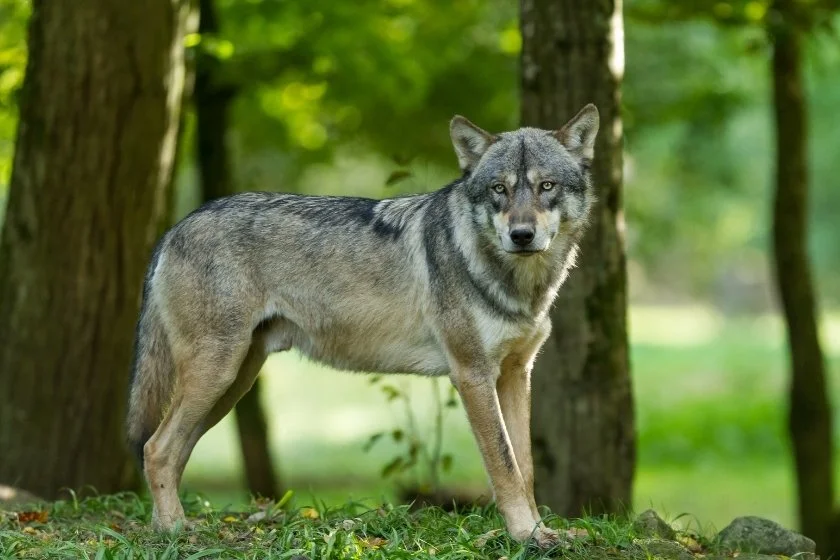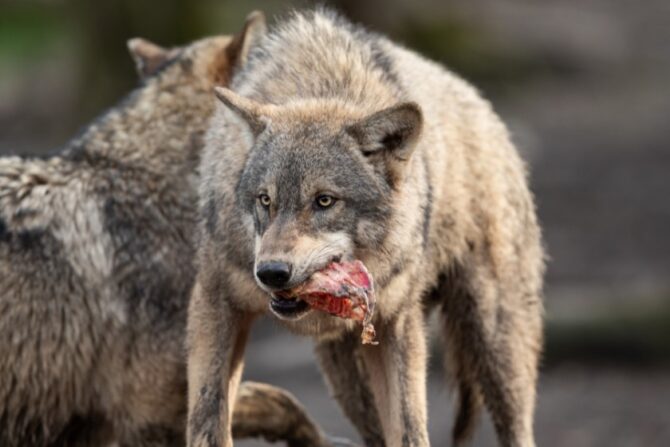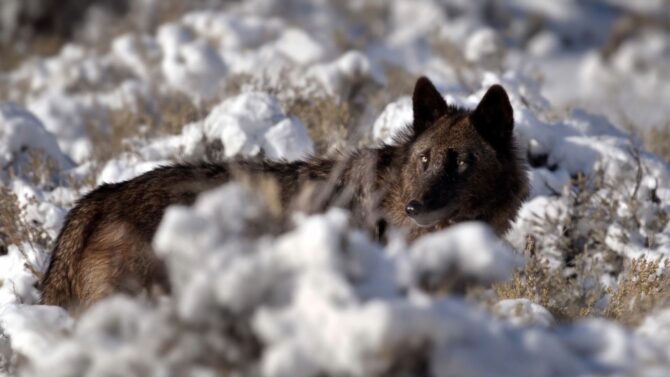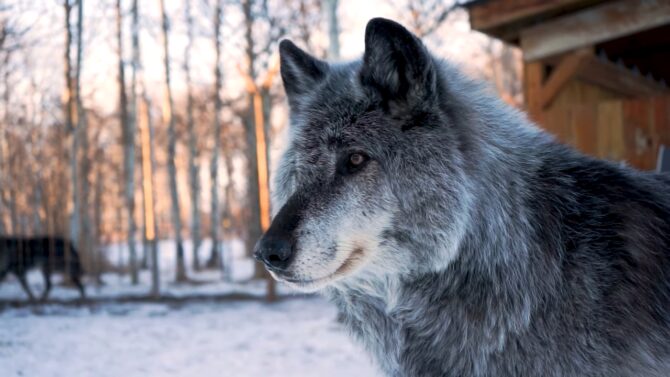The wolf (Canis lupus) is a social animal that lives and hunts in groups known as packs.
With more than thirty extant subspecies, this mammal is the largest non-domestic member of the Canidae family that can still be found on four continents.
Wolves are quite different from dogs, despite sharing common ancestors. These wild dog species are distinguished by their large appetite, broad snout, short ears, long bushy tail, and long legs designed to travel long distances at great speed.
With humans as a wolf’s greatest threat, does this apex predator allow itself to be easily preyed upon? What is its primary habitat, mating behavior, and reproduction process?
Let’s learn more about this animal, which Mongolians consider a good luck symbol, particularly for men.
Scientific Classification

| Kingdom | Animalia |
| Phylum | Chordata |
| Class | Mammalia |
| Order | Carnivora |
| Family | Canidae |
| Genus | Canis |
| Species | C. lupus |
| Binomial Name | Canis lupus |
Wolf Characteristics
| Height | 105 – 160cm in length, 80 – 85cm at shoulder height |
| Weight | 26 – 175 lbs |
| Venom/Poison | No |
| Skin Type | Fur |
| Habitat | Tundra, woodlands, forests, grasslands, deserts, inlands, wetlands |
| Range | North America, Europe, Asia, and Africa |
| Diet | Carnivore |
| Lifespan | 8 – 14 years in the wild, 15 years and more in captivity |
| Gestation Period | 62 to 75 days |
| Conservation Status | Least concern (population stable) |
5 Interesting Facts About Wolves
1. Wolves’ eyes glow in the dark
Although slightly blurry, a wolf’s night vision is far superior to that of humans.
Because of their keen vision, they can hunt and move around at night without difficulty.
Their eyes glow in the dark like those of dogs, cats, and some other animals. The nighttime glow in a wolf’s eyes is light being reflected.
A light-reflecting layer called Tapetum lucidum is present in this animal’s eyes and it reflects light along the same path it came; which means light passing through the retina is reflected into the eye.
Because wolves are crepuscular animals, the Tapetum lucidum is crucial to their vision during low-light periods, particularly at night.
This layer that reflects light not only improves night vision but also leaves the eyes glowing at night.
2. They are loyal to their partners
Wolves are typically monogamous animals that mate with only one partner for the rest of their lives to produce healthy and strong wolf pups.
They usually stick with the same mating partner for life until “death do them part.” While many humans struggle with chastity and loyalty, these wild dogs do so with ease.
The wolf is the most loyal among mammals, and this trait helps them stay together in a pack for a long time.
Some wolves, Alpha males to be precise, have shown polygamous tendencies.
They find it difficult to resist the attractive female wolves in the pack, so they will take on multiple mates at once, with the primary aim to increase their pack size.
3. Wolves have webbed feet
Wolves have unusually large feet. Small webs extend half the size of each toe between their large paws.
With this incredible feature, they make excellent swimmers, able to swim across large bodies of water such as rivers, lakes, and so on, even over long distances (such as 8 miles at once!)
The webbing between a wolf’s toes also serves another purpose: it serves as a shovel, allowing them to be better diggers.
Their webbed feet also allow them to move around easily, make longer strides, and have a better grip on the ground than most animals in their habitat.
4. Alpha wolves are breeders, not supreme pack leaders
The term “Alpha wolf” is frequently misinterpreted to mean the leader or top dog in the wolf pack who has fought his way to dominance and reigns superior to other wolves in the pack, as animal behaviorist Rudolph Schenkel proposed in his seminal paper “Expressions Studies on Wolves” published in 1947.
Other animal behaviorists, such as L. David Mech has come forward in recent years to debunk Schenkel’s notions of alpha wolves and a competition-based pack system.
Many consider Mech’s paper “Alpha Status, Dominance, and Division of Labor in Wolf Packs,” published in 1999, to be a watershed moment in understanding the structure of wolf packs.
He claims that the concept of the alpha wolf being the supreme leader in a pack is incorrect because wolves do not have an inborn sense of rank; they are not born leaders or born followers.
The “alphas” are “parents” in any other social group – they only assert dominance over their offspring simply by being parents.
5. Wolves are adept communicators

Wolves are complex and highly intelligent animals that have perfected various communication methods.
They can communicate to care for and feed their young and defend their common territory and themselves.
These animals communicate using sounds, special scents, and body movements as communication extends beyond just talking or writing.
Wolves communicate using a variety of sounds, including howls, barks, whimpers, yelps, snarls, and growls.
They convey much information, such as pack rules, through body language, including facial expressions.
They can also communicate using special scents such as scats, urine, and pheromones because they have a very good sense of smell that is about 100 times greater than humans.
General Description
The Canidae family includes the largest extant non-domestic member, the wolf.
There are approximately three wolf species and close to forty subspecies, according to the Integrated Taxonomic Information System (ITIS), though some scientists disagree with these totals.
The Gray wolf, Red wolf, and Eastern wolf are the three species.
Due to similarities in appearance, many people continue to mistake wolves for coyotes and jackals.
However, wolves can be identified by their longer tails, shorter torsos, and broader snouts.
They are slender and powerfully built with a large head, powerful jaw, small triangular ears, broad forehead, long blunt muzzle which is narrower in a female wolf, sloping back and a heavily muscled neck.
The wolf’s legs are slightly longer than those of other canids because they were designed to travel and get in shape for a life of hunting.
Thanks to this trait, the animal can move quickly and navigate the deep snow that covers most of its geographic range in winter.
Wolves have powerful and pretty sizeable teeth. They are more suited to crushing bone than other canids, despite not being as specialized as those found in hyenas.
Wolves are primarily carnivorous creatures with enormous appetites. They prefer eating large-hoofed animals but also eat a variety of meat, including small mammals like beavers, rabbits, and rodents.
An adult wolf measures 105–160 cm long and 80–85 cm at the shoulder. The tail measures 29 to 50 cm in length.
The C. lupus weighs an average of 40 kg (88 lb), with the smallest specimen weighing 12 kg (26 lb) and the largest weighing 79.4 kg (175 lb).
Compared to a dog’s fur, wolfs’ offer better insulation. Theirs are extremely dense and fluffy and protect them during winter.
Typically, they have hair that is a mixture of white, brown, gray, and black, but it is not uncommon to see some species with brightly colored coats, such as the Eurasian wolf, which has a mix of brighter colors and a lighter shade of gray.
It is important to note that coat colors vary across individuals, species, and geographical areas. Wolves have two layers of fur: an outer layer that serves as a guard and an inner layer.
Long, coarse hairs that shed water and snow and contain pigments that give the wolf’s coat its color make up its outer layer, while thick, soft gray “wool,” makes up the inner layer, traps air, and protects the wolf from the elements.
Wolves can tolerate temperatures well below zero thanks to these layers’ extreme warmth.
Distribution and Habitat
One of the most widely known and distributed terrestrial mammals is the wolf. They can thrive in various habitats, provided that it’s closer to areas where large ungulates reside.
These habitats include remote locations, rocky summits, xeric shrublands, forests, tundras, swamps, pastures, inland wetlands, and grasslands.
They reside in areas where the temperature ranges from -56°C to +50°C (-70°F to +120°F) and the latitude ranges from 75°N to 12°N.
About 200,000 and 250,000 wolves are thought to still be in existence and can be found in nearly 70 nations across four continents, namely North America, Europe, Asia, and Africa, though some speculations might be absent in Africa.
This large member of the Canidae family used to be found in every hemisphere of the planet, but as their population keeps declining drastically, they are beginning to go extinct in some countries like Japan, Austria, Belgium, Switzerland, Bangladesh, Ireland, the Netherlands, Luxembourg, Denmark, and the United Kingdom.
This decline is a result of environmental change, government policies intended to eradicate wolves, human persecution, and other obstacles to population growth.
Diet

Like most wild animals, wolves are scavengers and hunters that are not overly particular about what they eat.
They have large stomachs and can devour 20 – 25 pounds of food at any feeding time. However, wolves can survive without food for up to 2 weeks or even longer if the prey is scarce.
Although you can find wolves occasionally munching on a negligible amount of fruits and veggies, they are considered carnivores instead of omnivores.
This vegetal matter is not a significant part of their diet as it does not sustain them for too long, and they only consume them to supplement their meat-based diet, especially during scarcity.
A wolf would also eat grass, but not for its nutritional value; rather, they would do so after consuming something that didn’t agree with their bodies.
The grass causes them to vomit, which aids in eliminating unhealthy food from their systems.
Large, hoofed mammals like moose, elk, deer, caribou, bison, musk oxen, mountain goats, and sheep are common food sources for wolves.
Smaller mammals like beavers, hares, squirrels, rabbits, grouse, rodents, etc., are also prey for them. Also, prey on by wolves is birds and reptiles.
Reproduction and Mating Process
Wolves reproduce by a male mounting a female and copulating; the female then gives birth to a litter.
They breed only once a year, and this is between the dominant “alpha” male and female within their pack.
A wolf pack typically only produces one litter per year, usually consisting of four to six pups (although they can be as many as ten pups in a litter).
The entire pack raises these pups in dens after they are born alive.
Wolves typically reach sexual maturity at 1 to 2 years of age. Their mating season is between February and March, and the pups are born in the middle of May after a 60–63 day gestation period.
When the pups are about to be born, the pair selects a den, typically a straightforward protected area, such as beneath the lower branches of a spruce.
After about one to three weeks, they relocate the pups to a more permanent den, which is frequently close to water.
This den will have a more durable structure and might even be a real cave dug in the sand.
One of the more experienced wolves in the pack is always watching over the pups.
When the alpha wolves are about to mate, they become closer and touch each other more frequently while they sleep.
They will mouth each other’s muzzles, touch noses, whip tails, and bump bodies as they come closer while making low whining noises.
The two may walk together while grooming and nibbling at each other’s coats. They might even nap together.
It is only appropriate to describe the male’s actions toward the female as flirtatious when he bows to her, tosses and tilts his head, and lays his legs over her neck.
The male will smell the female’s genital area as the courtship develops to determine whether she is ready to mate.
He will flick his tongue in and out to check the air for traces of her sex hormones. If the female wolf is not sexually open, she will repel the male with growls and snaps of her jaws.
Wolves reproduce similarly to dogs, with the male mounting the female from behind.
The alpha male’s penis swells during mating, and the female’s vaginal wall contracts, creating a real physical tie.
After about five minutes, the male will eventually stop and turn around so that the two are end-to-end. (This could be the location of the actual sperm exchange.) The two will remain tied for the next 30 minutes.
Following mating, couples will remain close. Although wolves frequently form strong bonds with their partners.
The long-held “mate for life” myth may also be debunked because some males may form bonds with various females for several years.
Predators and Threats
Although wolves are apex predators that rarely get preyed upon, it is not uncommon to witness this happening (other animals hunting and feeding on them.) Studies have shown that most of these other animals’ attacks on wolves are motivated primarily by territorial disputes.
There are still animals that will eat wolves even though they are excellent hunters and are quite high on the food chain. They include polar bears, Siberian tigers, grizzly bears, scavenger animals, and people.
Although it happens very infrequently, wolves can also attack and consume one another. It is truly a dog-eat-dog world out there in the wild.
Despite having the size, strength, and speed necessary to hunt down wolves, these other animals would prefer not to because they get killed in the process. Wolf numbers are in their favor.
Because they travel in packs, it is challenging for their adversaries to focus on a single wolf or the entire pack.
The primary predators of wolves are Humans. People hunt wolves for meat, furs, sport, and other reasons.
Given the technology, weapons, and equipment we have at our disposal, we pose a serious threat to their population.
Behavior
Wolves are social creatures that live in packs, which is their fundamental social structure. A pack consists of a mated pair and their young.
The typical pack is made up of a family of 8 wolves, though there are known instances of exceptionally large packs that contain up to 42 wolves.
A pack of wolves is hostile to outsiders and even other packs close by. Sometimes a lone wolf is taken in by a pack to take the place of a dead breeder. This adopted wolf is almost always young and between one and three years old.
Wolves are territorial and typically create territories much larger than they need to survive. The amount of available prey and the age of the pack’s pups have a significant impact on the size of the territory.
When the pups are six months old and have the same nutritional requirements as adults, they grow in size in areas with low prey populations.
In constant pursuit of prey, wolf packs cover about 9% of their range daily, or 25 km per day on average.
Except in extreme circumstances, they generally stay within their private home ranges and steer clear of hunting outside it to avoid deadly encounters with nearby packs.
To communicate, wolves use their vocalizations (growls, barks, whines, etc.), body language, scent, touch, and taste.
Contrary to commonly believed, they don’t howl at the moon. They howl to gather the pack before and after hunts to signal an alarm, especially at the den’s location, to find one another during a storm, navigate new terrain, and communicate over great distances.
Under certain circumstances, their howls can be heard over 130 miles away. They do not bark as frequently or loudly as dogs do during confrontations; instead, they bark a few times before escaping a perceived threat.
Urine, feces, and anal gland scents are used in scent marking. They are frequently combined with scratch marks and are more effective at promoting a territory than howling.
When they come across the scent markings of wolves from other packs, wolves increase their rate of scent marking. Only recently bonded pairs will scent mark more frequently than lone wolves.
These marks are typically left every 240 meters on every pathway throughout the territory. They are frequently positioned close to large animal skeletons, trees, rocks, and boulders and may last up to two or three weeks.
Given that raised leg urination accounts for 60–80% of all scent marks found, it is regarded as one of the most significant wolf scent communication techniques.
Male vs. Female
Both males and females play an equally important role in a wolf pack. Despite having distinct roles within the pack and different physical characteristics, both genders cooperate for the benefit of their community.
she-wolf is the term used to refer to the pack’s female members. They are expected to play the lead roles in hunts while the male members handle the more difficult ones themselves.
The luna wolf is the most significant female member of the pack. The term “alpha female” refers to her because she is regarded as the pack’s matriarch.
The luna wolf is the alpha male’s partner, bears his children, and takes care of matters when he isn’t around. She is in charge of caring for the pack’s members and ensuring that they grow up comfortably and healthily.
While the other male wolves in the pack are referred to as Beta and Omega males, the male parents of the pack are known as Alpha males. The only males who have the authority to mate with the Luna wolf are those who are the alpha male.
Beta males wait until they are mature enough to leave the pack and start a new pack because they are younger than the alphas. Omega wolves are the lowest in the wolf structure and are most frequently spotted in zoos.
Normally, the alpha male (so named because he is the top male parent in the pack) displays great dominance over others, but during mating season, the alpha female takes control.
Female wolves seem to be slightly smaller than male wolves in the wild. They are smaller and appear thinner, weighing between 60 and 95 pounds, as opposed to the fluffier, and bigger male wolves, which weigh between 75 and 120 pounds.
Finally, research has shown that male wolves are more likely to be fiercely aggressive toward other packs than female wolves because of their high cortisol levels.
Frequently Asked Questions
How do you identify a wolf?
A wolf resembles a large dog. In comparison to dogs, they have a wider and more colorful faces, cheeks with coarse hair, and black lips encircled by white fur (mask).
Wolves appear stronger overall, with larger legs and a straighter back than dogs. They also have bushy tails with black ends and are mostly down and straight.
Typically, wolves live in packs. An alpha pair and its offspring make up the pack. Although they can be found alone, in pairs, or in smaller groups during the summer, the entire pack congregates during the winter. Therefore, if you see these enormous dogs prowling around, they might be wolves; you never know.
Are wolves dangerous to humans?
Normally, wolves in the wild don’t threaten people. They are extremely wary of humans, and would generally avoid interacting with people (unless they have gotten used to them).
Adult wolves usually assess the situation first when confronted by humans and then retreat. On the other hand, their pups are known to be innocent and curious, so they will linger and watch. Rabid wolves are primarily to blame for many attacks on people.
How strong is a wolf’s bite?
Wolves’ jaws are incredibly strong, and they have a remarkable set of teeth. A large domestic dog’s bite force is around 320 pounds per square inch, while a human only has about 120 pounds per square inch. However, a wolf’s bite force is almost 1500 pounds per square inch!
Is a wolf stronger than a dog?
Wolves outpace all dog breeds except for a few rare ones in terms of strength, endurance, bite force, and speed.
Conclusion
It is very unlikely that you would ever encounter wolves because they are wary of humans and avoid contact with us.
Unless provoked, they generally don’t act aggressively toward people, but you would also need to watch out for wolves with rabies as they’re very dangerous and will attack unprovoked.








